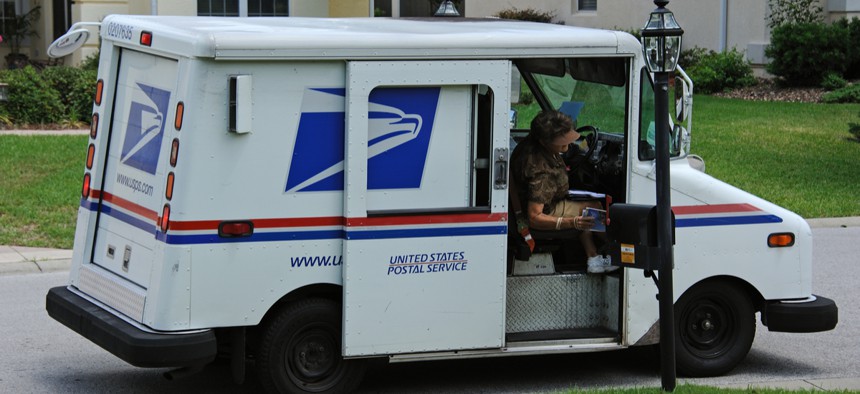
Peter Titmuss / Shutterstock.com
The Quiet Heroism of Mail Delivery
After a natural disaster, courier services such as USPS and UPS help communities return to a sense of normalcy.
On Wednesday, a polar vortex brought bitter cold to the Midwest. Overnight, Chicago reached a low of 21 degrees Fahrenheit below zero, making it slightly colder than Antarctica, Alaska, and the North Pole. Wind chills were 64 degrees below zero in Park Rapids, Minnesota, and 45 degrees below zero in Buffalo, North Dakota, according to the National Weather Service. Schools, restaurants, and businesses closed, and more than 1,000 flights have been canceled.
Even the United States Postal Service stalled mail delivery, temporarily. “Due to this arctic outbreak and concerns for the safety of USPS employees,” USPS announced Wednesday morning, “the Postal Service is suspending delivery Jan. 30 in the following 3-digit ZIP Code locations.” Twelve regions were listedas unsafe on Wednesday; on Thursday, eight remained.
As global surface temperatures increase, so does the likelihood of extreme weather. In 2018 alone, wildfires, volcanic eruptions, hurricanes, mudslides, and other natural disasters cost at least $49 billion in the United States. As my colleague Vann R. Newkirk II reported, Puerto Rico is still confronting economic and structural devastation and resource scarcity from 2017’s Hurricane Maria. Natural disasters can wreck a community’s infrastructure, upending systems for months or years. Some services, however, remind us that life will eventually return, in some form, to normal.
Days after the deadly 2017 wildfires in Santa Rosa, California, a drone caught footage of a USPS worker, Trevor Smith, driving through charred homes in that customary white van, collecting mail in an affected area. The video is striking: The operation is familiar, but the scene is apocalyptic. According to Rae Ann Haight, the program manager for the national-preparedness office at USPS, Smith was fulfilling a request made by some of the evacuees to pick up any mail that was left untouched. For Smith, this was just another day on the job. “I followed my route like I normally do,” Smith told a reporter. “As I’d come across a box that was up but with no house, I checked, and there was mail—outgoing mail—in it. And so we picked those up and carried on.”
USPS has sophisticated contingency plans for natural disasters. Across the country, 285 emergency-management teams are devoted to crisis control; Pat Mendonca, the senior director of the office of postmaster general, told me that these teams are trained annually using a framework known as the three p’s: people, property, product. After a weather-necessitated service outage, the agency’s top priority is ensuring that employees are safe, after which it evaluates the health of infrastructure, such as the roads that mail carriers drive on. Finally, it decides when and how to reopen operations.
If the devastation is extreme, mail addressed to the area will get sent elsewhere. In response to Hurricane Katrina in 2005, USPS preemptively diverted inbound New Orleans mail to Houston. Mail that was already processed in New Orleans facilities was moved to an upper floor so it would be protected from water damage.
But the agency aims not to keep delivery suspended for too long. “It’s our drive to get back out on the street with our carriers,” Mike Swigart, the director of national preparedness at USPS, told me in December, “because that’s our legislative responsibility.”
As soon as it’s safe enough to be outside, couriers start distributing accumulated mail on the still-navigable routes. USPS urges those without standing addresses to file change-of-address forms with their new location. After Hurricane Katrina hit in 2005, mail facilities were set up at the Houston Astrodome and in dozens of other locations across the country in the two weeks that USPS was unable to provide street delivery.
Every day, USPS processes, on average, 493.4 million pieces of mail—anything from postcards to Social Security checks to medicine. Spokespeople from both USPS and UPS told me all mail is important. But some mail can be extremely sensitive and timely. According to data released by ACI Worldwide and Aite Group in January 2017, 56 percent of bills are paid online, which means that just under half of payments still rely on delivery services to be completed.
It can be hard to identify which parcels are carrying crucial items such as Social Security checks, but USPS and UPS try their best to prioritize sensitive material. Swigart said that the benefit of being a federal agency is that USPS works “with other federal administrations, [and has] relationships with the state because we’re dealing with them every day.” They will, for example, coordinate with the Social Security Administration to make sure that Social Security checks reach the right people in a timely fashion. In the aftermaths of Hurricane Florence and Hurricane Michael last fall, USPS worked with state and local election boards to make sure that absentee ballots were available and received on time.
Mail companies are logistics companies, which puts them in a special position to help when disaster strikes. In a 2011 USPS case study, the agency emphasized its massive infrastructure as a “unique federal asset” to be called upon in a disaster or terrorist attack. “I think we’re unique as a federal agency,” Swigart told me, “because we’re in literally every community in this country … We’re obligated to deliver to that point on a daily basis.”
Private courier companies, which have more dollars to spend, use their expertise in logistics to help revitalize damaged areas after a disaster.
For more than a decade, FedEx has supported the American Red Cross in its effort to get emergency supplies to areas affected by disasters, both domestically and internationally. It also donates millions of dollars to support responders and victims, according to a 2012 internal report, and sponsors organizations such as the Salvation Army. This same report explains that in the 2012 fiscal year—the year of Hurricane Sandy, the Rush Fire in California, and the Kamaishi earthquake and tsunami in Japan—the company transported the equivalent of 53 planes filled with donated aid, distributed more than 1,200 MedPacks to Medical Reserve Corps groups in California, and donated space for 3.1 million pounds of charitable shipping globally. Last October, the company pledged $1 million in cash and transportation support for Hurricanes Florence and Michael.
UPS’s philanthropic arm, the UPS Foundation, uses the company’s logistics to help disaster-struck areas rebuild. “We realize that as a company with people, trucks, warehouses, we needed to play a larger role,” said Eduardo Martinez, the president of the UPS Foundation. The company employs its trucks and planes to deliver food, medicine, and water. The day before I spoke to Martinez in November, he had been touring the damage from Hurricane Michael in Florida with the American Red Cross. “We have an obligation to make sure our communities are thriving, prosperous,” he said. “Our people who live and work in these communities can be in the same circumstances.”
Rebuilding can take a long time, and even then, impressions of the disaster may still linger. “Katrina simply is our lives, whether we consciously acknowledge it or not,” Anne Gisleson, a Katrina survivor, wrote in The Atlanticin September. Returning to a sense of normalcy can be difficult, but some small routines—mail delivery being one of them—may help residents remember that their communities are still their communities.
“When they see that carrier back out on the street,” Swigart said, “that’s the first sign to them that life is starting to return to normal.”’






